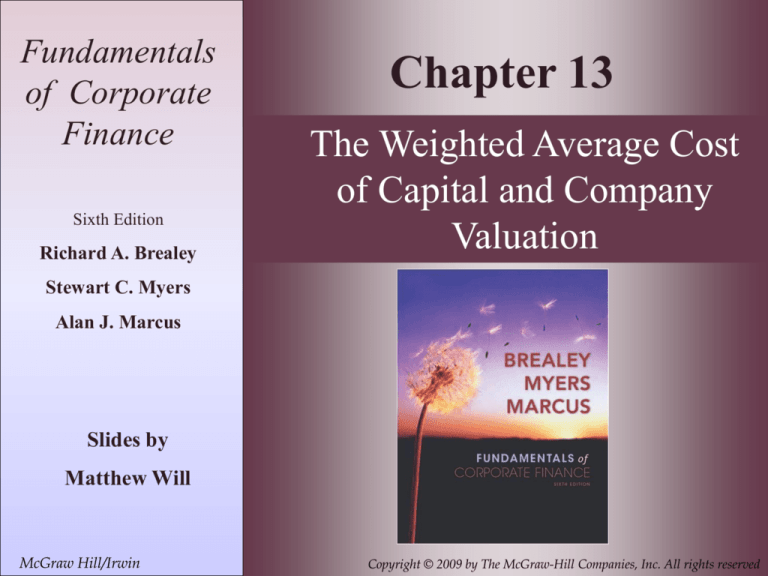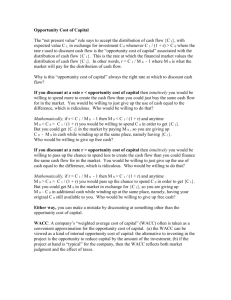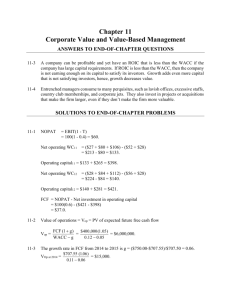
13- 1
Fundamentals
of Corporate
Finance
Sixth Edition
Richard A. Brealey
Chapter 13
The Weighted Average Cost
of Capital and Company
Valuation
Stewart C. Myers
Alan J. Marcus
Slides by
Matthew Will
McGraw
McGraw Hill/Irwin
Hill/Irwin
Copyright ©Copyright
2009 by The
McGraw-Hill
Companies, Inc.
All rights
reserved
© 2009
by The McGraw-Hill
Companies,
Inc.
All rights reserved
13- 2
Topics Covered
Geothermal’s Cost of Capital
Weighted Average Cost of Capital (WACC)
Measuring Capital Structure
Calculating Required Rates of Return
Calculating WACC
Interpreting WACC
Valuing Entire Businesses
13- 3
Cost of Capital
Cost of Capital - The return the firm’s
investors could expect to earn if they invested
in securities with comparable degrees of risk.
Capital Structure - The firm’s mix of long
term financing and equity financing.
13- 4
Cost of Capital
Example
Geothermal Inc. has
the following
structure. Given that
geothermal pays 8%
for debt and 14% for
equity, what is the
Company Cost of
Capital?
13- 5
Cost of Capital
Example - Geothermal Inc. has the following
structure. Given that geothermal pays 8% for debt
and 14% for equity, what is the Company Cost of
Capital?
Market Value Debt $194
Market Value Equity
$453
30%
70%
Market Value Assets $647 100%
13- 6
Cost of Capital
Example - Geothermal Inc. has the following
structure. Given that geothermal pays 8% for debt
and 14% for equity, what is the Company Cost of
Capital?
Portfolio Return = (.3 8%) + (.7 14%) = 12.2%
13- 7
Cost of Capital
Example - Geothermal Inc. has the following
structure. Given that geothermal pays 8% for debt
and 14% for equity, what is the Company Cost of
Capital?
Portfolio Return = (.3 8%) + (.7 14%) = 12.2%
Interest is tax deductible. Given a 35% tax rate, debt only
costs us 5.2% (i.e. 8 % x .65).
WACC = (.3 5.2%) + (.7 14%) = 11.4%
13- 8
WACC
Weighted Average Cost of Capital (WACC)
The expected rate of return on a portfolio of
all the firm’s securities, adjusted for tax
savings due to interest payments.
Company cost of capital = Weighted average of debt
and equity returns.
13- 9
WACC
rassets =
rassets
total income
value of investments
(D x rdebt ) + (E x requity)
V
rassets x rdebt x requity
D
V
E
V
13- 10
WACC
Taxes are an important consideration in the company
cost of capital because interest payments are
deducted from income before tax is calculated.
After - tax cost of debt = pretax cost x (1 - tax rate)
= rdebt x (1 - Tc)
13- 11
WACC
Weighted Average Cost of Capital = WACC
D
E
WACC = (1 - Tc )rdebt + requity
V
V
13- 12
WACC
Three Steps to Calculating Cost of Capital
1. Calculate the value of each security as a
proportion of the firm’s market value.
2. Determine the required rate of return on each
security.
3. Calculate a weighted average after tax return
on the debt and the return on the equity.
13- 13
WACC
Weighted Average Cost of Capital with
Preferred Stock
D
E
P
WACC = (1 - Tc )rdebt + requity + rPreferred
V
V
V
13- 14
WACC
Example - Executive Fruit has
issued debt, preferred stock and
common stock. The market
value of these securities are
$4mil, $2mil, and $6mil,
respectively. The required
returns are 6%, 12%, and 18%,
respectively.
Q: Determine the WACC for
Executive Fruit, Inc.
13- 15
WACC
Example - continued
Step 1
Firm Value = 4 + 2 + 6 = $12 mil
Step 2
Required returns are given
Step 3
WACC =
[
4
12
] (
x(1-.35).06 +
=.123 or 12.3%
2
12
) (
x.12 +
6
12
)
x.18
13- 16
Measuring Capital Structure
In estimating WACC, do not use the Book
Value of securities.
In estimating WACC, use the Market Value
of the securities.
Book Values often do not represent the true
market value of a firm’s securities.
13- 17
Measuring Capital Structure
Market Value of Bonds - PV of all coupons
and par value discounted at the current
YTM.
Market Value of Equity - Market price per
share multiplied by the number of
outstanding shares.
13- 18
Measuring Capital Structure
Big Oil Book Value Balance Sheet (mil)
Bank Debt
$
200
25.0%
LT Bonds
$
200
25.0%
Common Stock
$
100
12.5%
Retained Earnings $
300
37.5%
Total
$
800
100%
13- 19
Measuring Capital Structure
Big Oil Book Value Balance Sheet (mil)
Bank Debt
$
200
25.0%
LT Bonds
$
200
25.0%
Common Stock
$
100
12.5%
Retained Earnings $
300
37.5%
Total
$
800
100%
If the long term bonds pay an
8% coupon and mature in 12
years, what is their market
value assuming a 9% YTM?
16
16
16
216
PV
....
2
3
12
1.09 1.09 1.09
1.09
$185.70
13- 20
Measuring Capital Structure
Big Oil MARKET Value Balance Sheet (mil)
Bank Debt (mil)
$ 200.0
12.6%
LT Bonds
$ 185.7
11.7%
Total Debt
$ 385.7
24.3%
Common Stock
$ 1,200.0
75.7%
Total
$ 1,585.7
100.0%
13- 21
Required Rates of Return
Bonds
rd = YTM
Common Stock
re = CAPM
= rf + B(rm - rf )
13- 22
Required Rates of Return
Dividend Discount Model Cost of Equity
Perpetuity Growth Model =
Div1
P0 =
re - g
solve for re
Div1
re =
+ g
P0
13- 23
Required Rates of Return
Expected Return on Preferred Stock
Price of Preferred Stock =
P0 =
Div1
rpreferred
solve for preferred
rpreferred
Div1
=
P0
13- 24
WACC for Selected Firms
Amazon.com
Ford
Newmont Mining
Intel
Microsoft
Dell Computer
Boeing
McDonalds
Pfizer
Dupont
Disney
ExxonMobil
IBM
Wal-Mart
Campbell Soup
GE
Heinz
Expected
return
Interest rate Proportion of Proportion of
on equity (%) on debt (%) Equity (E/V) Debt (D/V) WACC (%) Mkt Cap Totl debt
19.8
7.3
0.96
0.04
19.3
33.8
1.2
20.2
7.7
0.07
0.93
6.1
12.2
163.2
8.9
6.5
0.89
0.11
8.4
24.2
3.0
14.1
5.8
0.98
0.02
13.9
111.2
2.0
10.3
na
1.00
0.00
10.3
311.7
0.0
11.9
6.0
0.99
0.01
11.8
47.8
0.7
11.6
5.8
0.88
0.12
10.7
62.4
8.6
13.1
5.9
0.89
0.11
12.1
62.5
7.8
7.7
5.3
0.95
0.05
7.5
159.3
8.7
11.7
6.0
0.81
0.19
10.2
38.9
9.0
10.0
6.0
0.78
0.22
8.7
55.5
15.5
8.7
5.3
1.00
0.00
8.7
465.0
0.0
10.9
5.8
0.80
0.20
9.5
140.7
35.3
4.7
5.7
0.80
0.20
4.5
190.0
47.4
6.2
6.0
0.82
0.18
5.8
12.6
2.8
8.3
5.3
0.41
0.59
5.4
344.0
491.0
7.1
6.7
0.73
0.27
6.4
14.3
5.3
Notes: 1. Expected return on equity is taken from Table 12-2
2. Interest rate on debt is calculated from yields on similarly rated bonds
3. D is the book value of the firm's debt,and E is the market value of
equity
4. WACC = (1 - .35) x rdebt x (D/V) + requity x (E/V)
13- 25
Interpreting WACC
The WACC is an appropriate discount rate
only for a project that is a carbon copy of the
firm's existing business
There are two costs of debt financing. The
explicit cost of debt is the rate of interest
bondholders demand. The implicit cost is the
required increase in return from equity.
13- 26
WACC
Issues in Using WACC
Debt has two costs. 1)return on debt and 2)increased cost of
equity demanded due to the increase in risk
Betas may change with capital structure
Bassets =
[
D
V
] [
x Bdebt +
E
V
]
x Bequity
Corporate taxes complicate the analysis and may change our
decision
13- 27
* FCF and PV *
Free Cash Flows (FCF) should be the
theoretical basis for all PV calculations.
FCF is a more accurate measurement of PV
than either Div or EPS.
The market price does not always reflect the
PV of FCF.
When valuing a business for purchase, always
use FCF.
13- 28
Capital Budgeting
Valuing a Business
The value of a business or project is usually computed as
the discounted value of FCF out to a valuation horizon
(H).
The valuation horizon is sometimes called the
terminal value and is calculated like PVGO.
FCF1
FCF2
FCFH
PVH
PV
...
1
2
H
(1 WACC ) (1 WACC )
(1 WACC )
(1 WACC ) H
13- 29
Capital Budgeting
Valuing a Business or Project
PV
FCF1
FCF2
FCFH
PVH
...
(1 WACC )1 (1 WACC ) 2
(1 WACC ) H (1 WACC ) H
PV (free cash flows)
PV (horizon value)
13- 30
Capital Budgeting
Example - Concatenator Manufacturing
79.5
Horizon Value)
2,271.40
.085 .05
73.6
87.1
102.9
34.1
40.2
2,271.40
PV(FCF)
2
3
4
5
1.085 1.085 1.085 1.085 1.085 1.0855
1,290.40
13- 31
Web Resources








